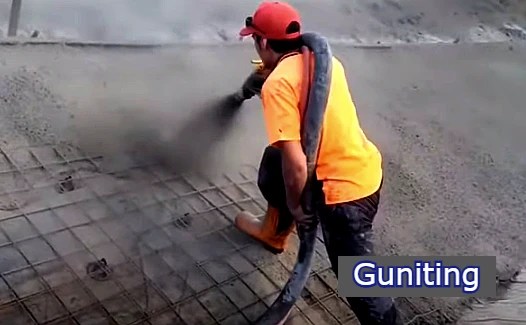What is Guniting?
Guniting is a process that uses an air-pressured stream of dry mix cement and sand, or a wet mix of cement, sand, and water.
The mixture is then sprayed onto a surface or into a formwork to create a durable, waterproof layer that can be used as a protective coating, or as a base layer for further construction.
Guiniting is a fast process. So, Guniting is a great choice for applications where a strong, water-resistant surface is needed.

It is commonly used for building fireproof walls and for strengthening existing walls and structures. The mixture consists of cement, sand, and water that is mixed to form a slurry before being forced through the nozzle.
This slurry is sprayed onto the surface in layers and left to dry, reinforcing the existing material and creating a solid bond.
Difference Between Guniting and Shotcrecting
Differences between shotcrete and guniting are tabulated below:
| Guniting | Shotcreting | |
| 1 | Begun in the early 1900 | Begun in recent years |
| 2 | Mortar is formed | Concrete is used |
| 3 | Coarse aggregates are not used at all | Small-sized coarse aggregates are used |
| 4 | Less thickness is obtained | Greater thickness can be obtained |
| 5 | Materials are conveyed through a hose in dry form till the nozzle | Materials can be conveyed in either dry/wet form till the nozzle |
Guniting Equipment
- Concrete gunite machine
- Guniting gun
- Air compressor
- Nozzle
- Hose for material, air, and water
- Pressure tank for water supply
- Admixture dispenser
Guniting Method/Guniting Procedure
The guniting concrete procedure is as follows:
- Cement and sand are mixed thoroughly
- Then special air pressure mechanical feeder known as the gun is filled with the prepared mixture of cement and sand
- Inside the gun, the cement-sand mixture is fed into the delivery hose with the help of a feed wheel or distributor
- The delivery hose carries the mixture to a special nozzle by compressed air
- Perforated manifold present inside this special nozzle spray water under pressure onto the cement-sand mixture (usage of more or less water content has an effect on guniting as discussed
- Water If admixtures are to be added, then they are mixed with water
- The quantity of water sprayed in the nozzle can be controlled by the operator with the help of regulating valve gets intimately mixed with cement-sand mixture forming the mortar.
- The mortar jet is sprayed out from the nozzle to the surface to be gunited at a high velocity of 90-120 m/s and a pressure of 2-3 kg/cm2.
- After each layer of gunite is applied, a spot-welded steel wire mesh fabric is provided.
- The diameter of the wire is 5mm.
- When the meshes are to be joined, they should overlap each other by one mesh so that continuity is maintained.
- The provision of wire mesh reduces initial shrinkage and prevents cracking in the freshly placed material.
The thickness of Guniting is limited to 200 mm according to cost considerations and design requirements. Maximum rate of deposition of guniting is 15 m3/h.
Guniting Specifications
Guniting work specifications are listed below:
- Guniting ratio of 1:3 is normally used in guniting.
- Water cement ratio of 0.3 is used normally during guniting.
- Maximum size of sand should not exceed 10 mm.
- Distance between the nozzle and the backing surface should not be more than 1 m.
- Nozzle velocity should not exceed 140 m/s.
- Rebound should not be re-used.
Uses of Guniting
Guniting is used for:
- Repair of dams, spillways, bridge piers, sewerage pipes, water mains
- Protection of canal banks
- Protection of steel girders from corrosion
- Waterproofing
- Lining of canals/reservoirs/tunnels
- Repair of spalled concrete structures due to corrosion in the reinforcement
- Repair of inferior quality concrete work
- Provision of impervious layer
- Concreting on curved or folded sections
- Concreting for horizontal/vertical surfaces or overhead surface
Advantages of Guniting
- Compressive strength of about 560-700 kg/cm2 can be obtained at 28 days
- High impermeability of the gunited surface is obtained
- Repairs can be done effectively in a short time
- Concreting can be done to the surface of any shape – undulating, spherical, or curved, hence it is versatile
- Concreting can be done to special shapes and features like swimming pools, waterfalls, etc
Disadvantages of Guniting
- Highly skilled labour is required
- Rebound of mix obtained is a waste
- Hauling of rebound material adds to the cost
- Dust hazard is high
- Work cannot be continued in adverse weather like windy weather
Key Takeaway
Guniting is generally prepared by the mixture of cement and sand kept at the ration of 1:3. i.e. one part of cement and three parts of sand.
Specifications for Guniting:
| Thickness of Guniting | ≯ 200 mm |
| Rate of deposition of guniting | ≯ 15 m3/h. |
| Velocity of guniting gun | 90-120 m/s |
| Pressure of guniting deposition | 2-3 kg/cm2 |
| Mix ratio of guniting | 1:3 |
| Diameter of wire mesh | 5 mm |
| Compressive strength at 28 days | 560-700 kg/cm2 |
| Addition of pozzolana | 5% by weight of cement |
I hope this article on “Guniting” remains helpful for you.
Civil Concept
Read More:-
Top 5 Cause of Honeycomb in Concrete – Remedies of Honeycomb
Honeycombing in concrete | Types, Effects, and Remedies of Honeycomb
Cause, Effect, and Types of Segregation of concrete
Properties of fresh and hardened Concrete – Segregation, Bleeding, etc